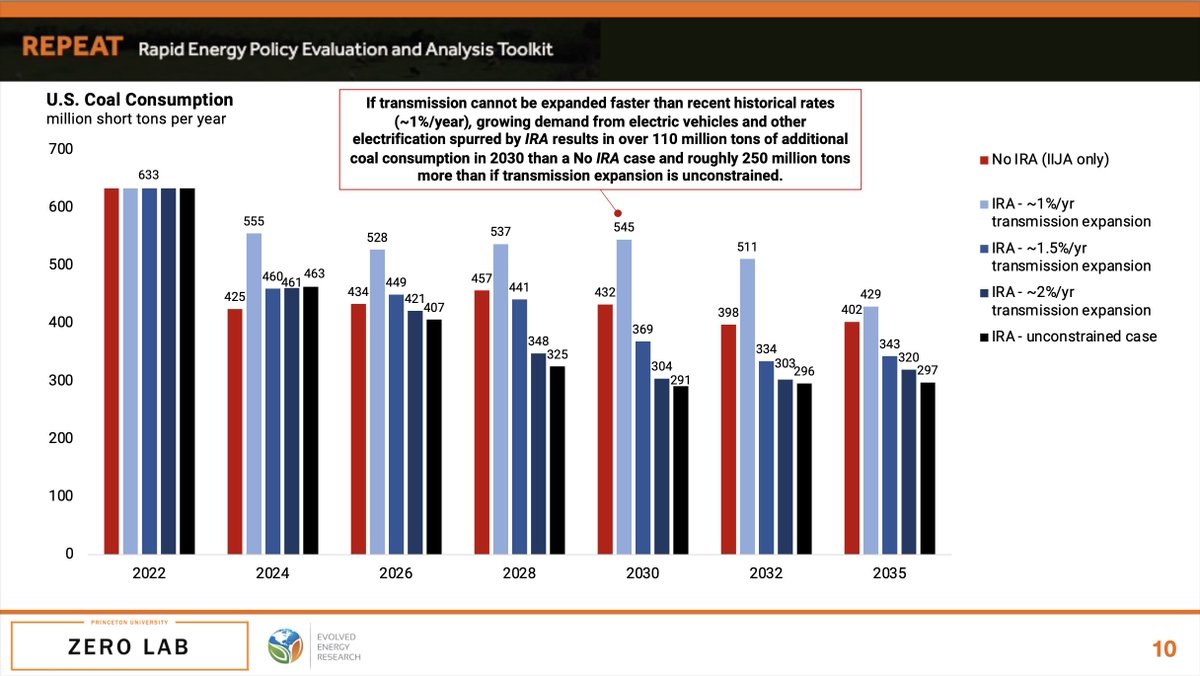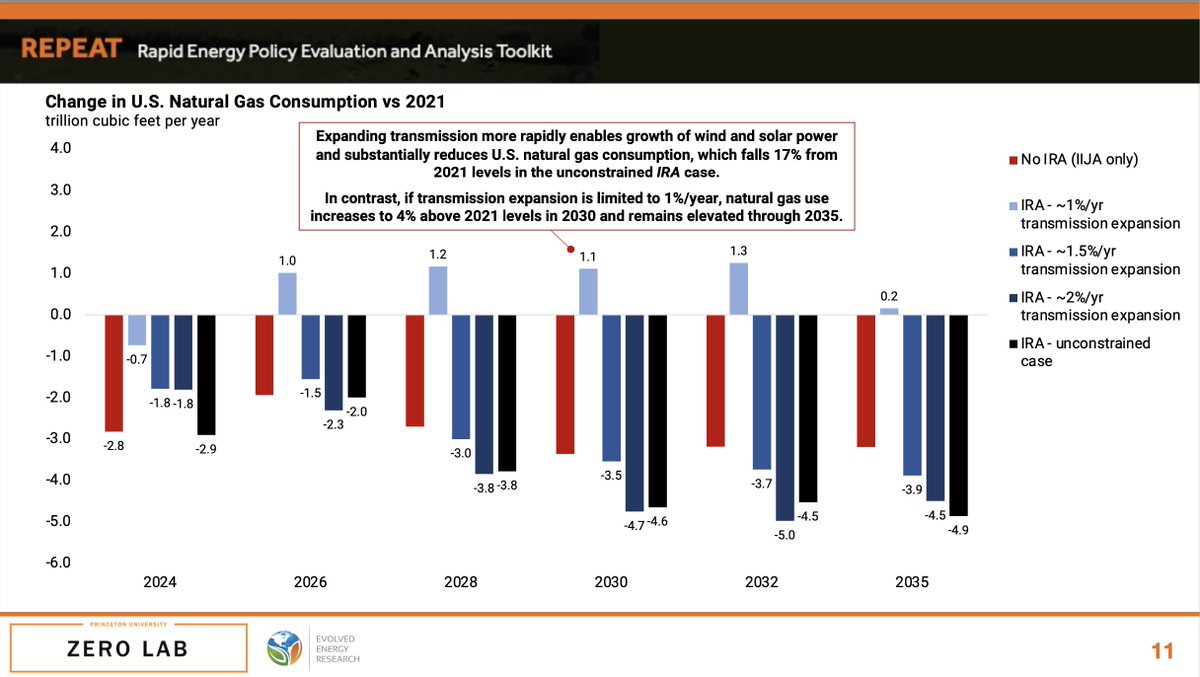
JesseJenkins@JesseJenkins
Sep 23, 2022
19 tweets
There's some good, bad & ugly provisions in Manchin's permitting reform bill (more here twitter.com/JesseJenkins/s).
Probably the ugliest is approval of the Mountain Valley Pipeline (MVP). I've been asked several times how to weigh climate/GHG impacts of this provision. Here's a 


JesseJenkins@JesseJenkins
Sep 22 22
View on Twitter
I've been meaning to do a thread on the good, bad, ugly of the bill but haven't had time to. In brief:
Transmission reform title: very very good.
NEPA: seems to be net good as well, especially given how many more clean energy projects there will be than dirty in coming years.
First, climate is NOT the only lens that matters here. Approving MVP is opposed by many local communities impacted by the project (vpm.org/news/articles/), and Congress approving specific projects and preventing Judicial review is a stark example of procedural injustice.
Executive agencies & courts should determine project siting decisions, NOT Congress. Explicitly denying ability for courts to review the MVP decision is also terrible precedent. Is that even Constitutional? Seems to violate separation of powers. This all has to be weighed too.
Of course, there are real environmental & public health impacts on other communities if we fail to accelerate deployment of clean electricity and enabling transmission lines, which the Manchin bill would also facilitate. This should be part of calculus too.
So how do we assess MVP in this national-scale context and what are the impacts on GHG emissions & natural gas production/use likely to be? How do these compare to emissions that can be avoided by accelerating transmission expansion and renewable electricity growth?
If we assume MVP enables 2 billion cubic feet per day (bcf/d) of new supply from the Marcellus region to get to market (and assume 100% is new supply rather than some existing Marcellus production rerouting to higher value markets), we can get a sense of the scale of this impact.
Given how tight current gas supply is, we might expect MVP to lead 1:1 to new consumption in short term. But typically, in medium term, new supply doesnt lead 1:1 to new consumption; it partly displaces other more costly supply. So net increase in production/use may be <2 bcf/d.
Assuming a medium-term elasticity of supply (0.3) & demand (0.2), ~40% of MVP supply will displace other production & ~60% will drive additional consumption or export.
That means MVP might lead to ~1.6-2 bcf/d (~0.6-0.7 tcf/y) of additional consumption or ~2% of 2021 US gas use
Failing to build transmission faster also significantly impacts US natural gas consumption though. Deploying wind & solar faster to displace natural gas (and coal) plants is THE biggest lever we have to drive down US gas demand in the next decade. twitter.com/JesseJenkins/s

JesseJenkins@JesseJenkins
Sep 22 22
View on Twitter
To meet growing demand for electricity, which we estimate could rise by ~24% by 2030 & ~43% by 2035, AND drive down power sector emissions and coal & gas use, we are going to need a bigger grid. Our original IRA analysis envisions 2.3%/year avg expansion of high-voltage capacity.
The power sector faces a twin challenge: drive down the dirty use of coal and natural gas AND keep up with the growth of electricity demand from EVs, heat pumps and more. Meeting that twin challenge requires building new clean electricity at record rates. We HAVE to build faster.
If we can build transmission at the full rate in REPEAT Project's unconstrained IRA cases (2.3%/yr), natural gas use is ~16 bcf/d or 5.8 tcf/y lower in 2030 than if we can only build at the 1%/yr avg rate over the past decade. That's equal to 10 MVPs & 21% of 2021 total gas use.
If transmission cannot be expanded faster than recent historical rates, growing demand from EVs and other electrification also drives roughly 250 million short tons more than coal consumption if transmission expansion is unconstrained. That's ~40% of current coal use!
What are the public health impacts of much higher gas and coal power generation? It amounts to a couple thousand premature deaths annually, plus associated asthma attacks, sick days, hospitalizations and other impacts we don't account for here.
To be very clear: we CANT say the transmission reforms in the Manchin bill alone will unlock this full potential! It is impossible to quantitatively predict impact of these reforms. My gut is that giving FERC siting & cost allocation authority are very important but insufficient.
It's plausible that by driving growing electricity demand & increasing incentives to build new renewables, IRA alone could accelerate transmission expansion without permitting reforms. The last time electricity demand steadily grew (in the 70s-90s), we expanded the grid at 2%/yr.
Increasing transmission expansion from 1%/yr to 1.5%/yr would lower US gas use by ~13 bcf/d, or '8 MVPs worth' / 17% of 2021 gas use.
Going from 1.5% to 2%/yr transmission growth reduces gas consumption by ~3.3 bcf/d or 'two MVPs worth'.
2% to 2.3%/yr is only 0.3 bcf/d though.
So how do we weigh all of this?
Net-net, from the aggregate perspective of how much fossil fuels are extracted & used & how much greenhouse gases are emitted, it is plausible the Manchin bill's transmission permitting reforms outweigh the damage from MVP. Possibly by several fold
But it is also impossible to say w/certainty how much transmission expansion will speed up with the reforms in the Manchin bill. How much do you think the bill's transmission reforms will help accelerate transmission expansion?
The Manchin bill is clearly a mixed bag (twitter.com/JesseJenkins/s)! There's the good (FERC transmission authority), bad (CWA changes) and ugly (MVP approval). And I cant unequivocally quantify net impacts. I hope the above thread provides some helpful context on the good & bad.

JesseJenkins@JesseJenkins
Sep 22 22
View on Twitter
I've been meaning to do a thread on the good, bad, ugly of the bill but haven't had time to. In brief:
Transmission reform title: very very good.
NEPA: seems to be net good as well, especially given how many more clean energy projects there will be than dirty in coming years.

JesseJenkins
@JesseJenkins
Macro-energy systems engineering, optimization, and policy w/a focus on electricity. Prof @EPrinceton (MAE) & @AndlingerCenter. PI of ZERO Lab. Personal account
Missing some tweets in this thread? Or failed to load images or videos? You can try to .











